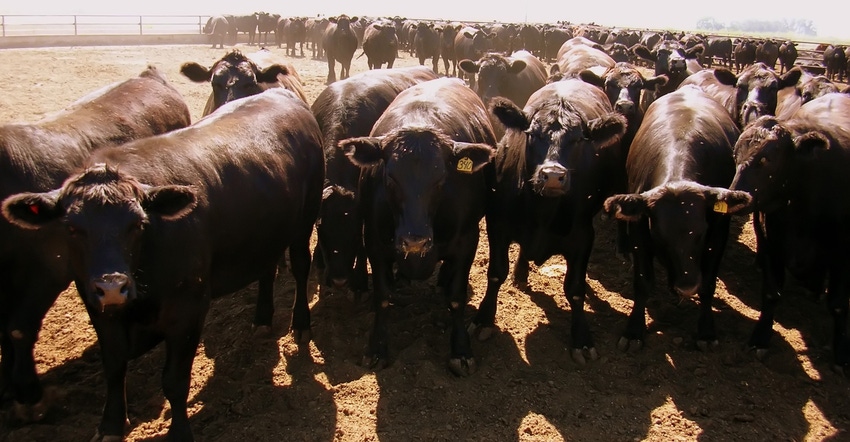Be vigilant to catch foot rot early
Watch for lameness and symmetric swelling of cattle’s feet this summer.

Foot rot is not uncommon for ranchers and feedlot owners. The disease is dependent on the weather and soil moisture, and though it can’t be completely prevented, it can be decreased and treated.
The stereotypical wet season of spring can make cattle stand in mud and soggy pasture, exposing their hooves to the bacteria that cause foot rot.
Robert Callan, professor of livestock medicine and surgery at Colorado State University, says during summer unique circumstances can make cattle more prone to foot rot — one being moisture.
“We don’t think of summer as being a wet season, but that moisture can come in variety of forms,” he says. “If cattle are on pasture and standing in ponds, that moisture can soften tissue between the claws of each foot and make the animal more susceptible to injury.”
If there is trauma to that area of the foot, when the animal moves away from moist areas and walks on hard, dry ground, it can cause abrasions and damage to the skin. These holes allow bacteria to move into the animal’s foot.
“Even if the cow moves from wet ground to very dry stubble or really rocky ground in the pasture, all of those mechanical factors can cause abrasions in its skin,” Callan says. “Once the infection is organized into the skin, this disease can progress rapidly, and in one to three days the animal can become extremely lame.”
Foot rot for cattle is similar to a hangnail on a person’s finger, where the area becomes inflamed. Only with foot rot, the animal is walking on the sore tissue. If foot rot is not treated properly, it moves into the animal’s joints and tendons.
Watch for lameness
One of the first noted signs of foot rot is lameness. Foot rot is more common in the back feet than front feet, and more common in adults than in young animals.
Callan says a rancher will notice symmetrical swelling in the cow’s heel bulb area. These tissues become redder due to the inflammation. If it progresses, he says the swelling can wrap forward around the coronary band, which is the tissue just at the top of the hoof wall.
Sometimes animals will have a fever, due to the infection. Also, because the disease causes intense pain, animals go off feed simply because it hurts to walk to the feeder and back.
The key physical indicator, Callan says, is that swelling on the animal’s foot is symmetrical.
“If you see an animal and look at the back of its foot, and the heel of one claw is more swollen than the other claw, it’s a sign of much deeper infection,” Callan says. “Those animals really need to get to a veterinarian because the infection may be in its joint or tendons. If you don’t look for asymmetry of the foot, then you may miss these deeper more severe infections, and it’ll be much more difficult to treat.”
Concrete and dry dirt floors help ranchers avoid foot root for the most part, but Callan also treats for the disease with a good health protocol.
Treatment protocol
Foot rot has been an issue at my family’s Angus farm, and we’ve always chosen to nip any chance for this disease in the bud.
Per the advice of my father, a former veterinarian, a shot of Exceed or Draxxin was given on the front end. And our feed program included a CTC mineral for the prevention of foot rot and pinkeye.
Dad would say the most effective treatment for foot rot is a shot of antibiotics. Many different antibiotics will work including penicillin, ampicillin (Polyflex) or oxytetracycline (LA 200, Biomycin, others) or florfenicol (Nuflor).
Oral sulpha boluses can also be used to treat foot rot. Some of these antibiotics, or the appropriate dosages needed to effectively treat foot rot, will need to be prescribed by your own veterinarian.
Most cases of foot rot will respond to treatment within three to five days. But if a rancher does not see improvement in three days, he or she should seek additional evaluation from their veterinarian.
During the three- to five-day period, it’s important to clean the cow’s toes. We did this by walking them into a chute or confined area, and using a garden hose to spray off feet and really get between the animal’s front toes.
The national average for foot rot is between 1% and 3% of pasture animals, and up to 5% of fed cattle. If the weather is wet, and the facilities do not drain or allow for dry ground, mud will stay in a cow’s foot crevices, create abrasions and cause infection. If a rancher or feedyard has a high stocking density, infection rates can increase up 30%.
People don’t consistently think about this disease, but anywhere that water collects can be problematic. Leaving the hose on too long and allowing water to overflow from the tank leads to muddy conditions and an opportunity for the bacteria to proliferate. Certain areas with urine-soaked mud also can lead to an infectious area of foot rot.
It’s important to stay on top of all animal diseases, but maintaining prevention of foot rot is something all cattle producers must do. Nipping it in the bud is better than catching it between the toes.
McCurry writes from Colwich, Kan.
About the Author(s)
You May Also Like


.png?width=300&auto=webp&quality=80&disable=upscale)
